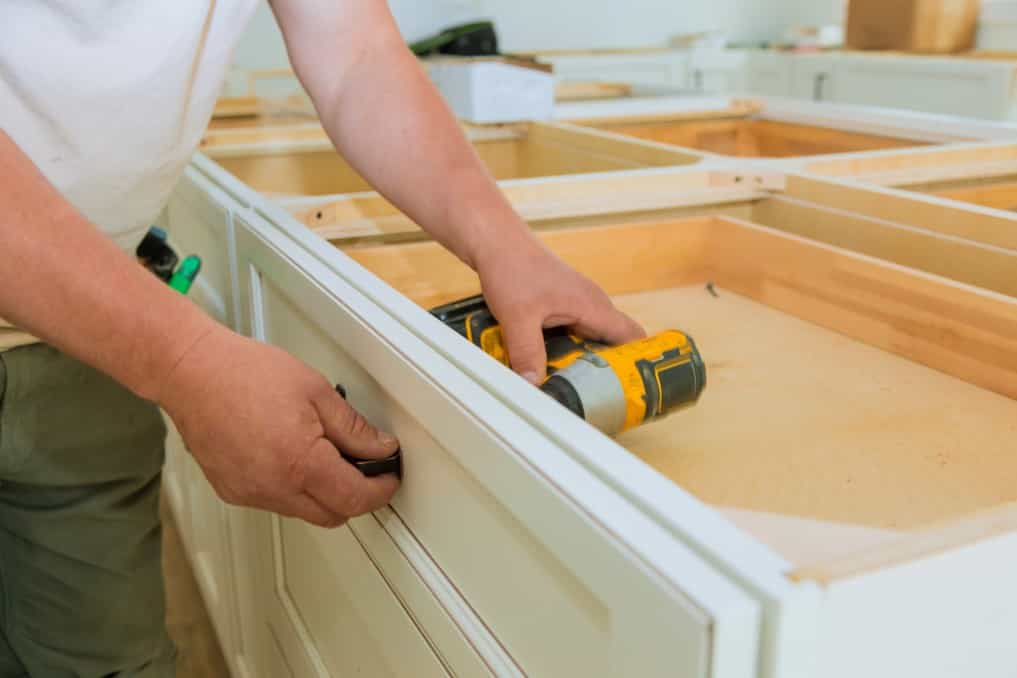If you know how to install kitchen cabinet handles, you can guarantee a seamless kitchen cabinet project. Unfortunately, this is a common step that most homeowners don’t pay attention to so much.

But if you want to uplevel your cabinet’s look like a pro’s work, you will need to follow the proper process.
How to Install Kitchen Cabinet Handles
Knowing how to install kitchen cabinet handles will save you from a poor and lopsided outcome. With the proper placement, your kitchen cabinet handles will accentuate the lines and colors of your overall kitchen space.
Furthermore, it can also boost your cabinet’s functionality and efficiency. As such, you have to learn and understand how to install kitchen cabinet handles before jumping right into the project.
Here’s a step-by-step look at what you should do and take note of:
Step 1: Try Placing the Handle on Different Positions
Note that there’s no one way to measure the handle placements. The best way how to install kitchen cabinet handles varies greatly depending on the cabinet orientation.
It’s important to test out different locations and see how it would look like. You can temporarily attach the handles using a putty adhesive and mark the best location.
Here the standard practices for knobs and pulls on how to install kitchen cabinet handles:
- Knobs: Align the knob with the upper part of the bottom door rail.
- Pulls: Align the bottom part of the pull with the upper door rail.
Meanwhile, here are some suggestions on how to install kitchen cabinet handles depending on cabinet type:
- Drawers: Door panel center
- Large wall cabinets: Above the bottom part of the door panel at arm’s reach
- Base cabinets: Top part of the door panel at arm’s reach
- Small wall cabinets: Middle of the door panel
Step 2: Use a Template
Another way how to install kitchen cabinet handles properly is to use a template. Depending on your preference, you can use a store-bought or a custom-made template.
It doesn’t only speed up the process but also decreases the chance of mistakes. If you opt to purchase, make sure to cover unnecessary holes using masking tape to avoid drilling incorrectly.
Once you find the proper location, use an awl to mark the holes to keep the drill in place upon drilling.
Step 3: Cover Old Holes
If you’re switching to a handle with a different hole pattern, make sure to cover the old holes.
The best way to do this is by using backplates, which are easy to purchase. If it doesn’t work, you can also apply putty to fill them.
Step 4: Use a Jig
Not using a jig on how to install kitchen cabinet handles can result in errors and inaccuracy. A jig is an adjustable tool built for installing cabinet hardware.
It keeps the holes in the same spot for similar doors for effortless and accurate drilling.
By using a jig, you can ensure consistent accuracy and proper distance and measurement of your handle installation.
Step 5: Start Drilling Small
Make sure to start by gently drilling a small hole on the cabinet surface on how to install kitchen cabinet handles Note that different handles would have different screw sizes.
This tip is to ensure that you’re not drilling an excessively large hole for the screw. It also helps you avoid splintering the cabinet backside.
When drilling, try to hold the drill as level as possible and with stability. Start from the door front too, again, avoid splintering the back of the door.
Step 6: Attach the Handle
Attach the handle by holding it in place in the cabinet front. Then, screw it in from the door backside until it’s tight enough.
Step 7: Repeat Process for Other Handles
After attaching the cabinet handle, make sure to brush off the dust and check for necessary touch-ups. Then, you’re good to go for repeating the process for other handles.
Where to Install Kitchen Cabinet Handles: Different Types of Handles
There is a myriad of different types of kitchen cabinet handles, from knobs to various pulls. Where to install kitchen cabinet handles may also vary depending on your chosen handle.
Confusing the proper placement of kitchen cabinet handles can impact the functionality of your space. It can also make them an eyesore since chances are their location is awry.
That said, here are some guidelines on where to install kitchen cabinets handles by type:
Cabinet Knobs
Cabinet knobs are the most common kitchen cabinet handle. You can use it for both large doors and small drawers alike.
They usually come in different shapes and appearances, from a round shape, square, to T-shape. The common materials used for knobs are ceramic and crystal.
Since you see it all the time in kitchens, it’s easy to know where to install kitchen cabinets handles like these. Knobs typically use a single screw so it’s fairly easy to attach.
Here are some important notes on where to install kitchen cabinets handles like knobs:
- Wall cabinets: 2 ½” to 3” from the door’s bottom corner
- Base cabinets: 2 ½” to 3” from the door’s upper corner
- Drawers and pull-out cabinets: Center front or upper front (the latter offers leverage when pulling a sink tilt-out tray)
Meanwhile, if you have a wide drawer, you can also place an additional knob to the door. The best way to do this is to divide it into thirds and place the knobs at the ⅓ and ⅔ points.
Bar and Wire Pulls
Bar and wire pulls are top in functionality with their easy-to-grasp feature. These types of kitchen cabinet handles usually use two screws.
Here are some important notes on where to install kitchen cabinets handles as bar and wire pull:
- Door: 2 ½” to 3” from the lower door front and centered on the door frame (vertical orientation)
- Drawers: Off-center (horizontal orientation)
- Pull-out storage: Centered on the door frame’s top rail (horizontal orientation)
If the pull-out storage is narrow, you can also place the handles in a vertical orientation.
Edge Pulls
We also refer to edge pulls as finger pulls or tab pulls. It creates a minimalist appearance for kitchen cabinets with contemporary style like slab-door cabinets.
Now, you have the flexibility on where to install kitchen cabinet handles like edge pulls. Make sure to position the edge pulls opposite the hinge.
They go well on the top and bottom edges of kitchen cabinet doors and drawers. You can either go for a centered or off-centered position depending on the look you’re going for.
Cup Pulls
Cup pulls or bin pulls are handles that appear like an upside-down cup. It creates a timeless look that can pull off any vibe you’re going for.
To pull this, you have to slip your fingers underneath to grasp the space and pull. The best location on where to install kitchen cabinets handles as cup pulls is in the center of drawers.
For cabinet door frames, position them vertically and position them in the center opposite the hinge.
Installing Kitchen Cabinet Handles Like a Pro
Your first kitchen cabinet project may be intimidating. While it seems simple at first glance, it’s quite complex to get every position right the first time.
So before you proceed to drill all those holes, you have to first master how to install kitchen cabinet handles.
Depending on the type of handle you prefer, the installation process can be different too.
Remember the formula to the optimum handle placement: it’s a combination of design and function.
